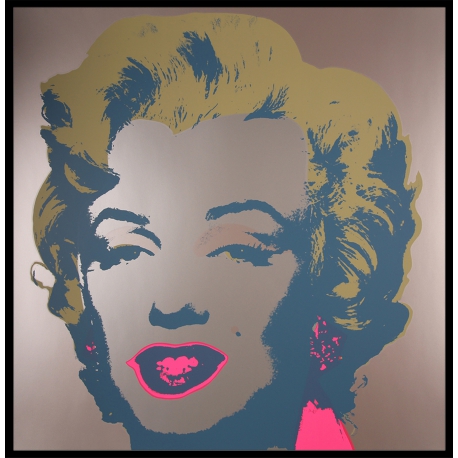No products
Artwork successfully added to your shopping cart
There are 0 items in your cart. There is 1 item in your cart.
Marilyn Monroe
Warhol, Andy
- After Andy Warhol 1962.
- Pop Art.
- Colour screen printing based on the original.
- Stamped by Sunday B. Morning on verso, with enclosed original certificate from Sunday B. Morning.
- Ready to hang with a black aluminium frame in 0.5 cm width and acrylic glass.
Based on a press photograph of Marilyn Monroe by Gene Korman for the 1953 film Niagara.
Original in the collection of the Tate Gallery of Modern Art in London.
Warhol's Marilyn is considered his most famous icon, as she represents the personification of American popular culture of her time like no other.
In his depictions of celebrities, Warhol shows the relationships between consumer society, fashion, fame, sensationalism and death.
In this society, the individual is seen more as a product or projection surface than as a human being.
The prominent starlets of the Popolymp are flawless in Warhol's depictions. The idealisation represents Warhol's feeling that these personalities were surrounded by an extraordinary aura and revered almost like sacred figures by their fans.
The Marilyn series was created only two weeks after her suicide. Warhol's portraits also remind us that behind the fame and glamour of these Hollywood careers were real people.
The silkscreen technique was an important part of Warhol's artistic creation, influencing his style and career, as it was the most effective method of producing mass prints in his time.
The most famous exponent of Pop Art, Andy Warhol created iconic motifs such as Marilyn Monroe, Campbell's soup cans and Mick Jagger, which have become part of the collective memory of Western consumer society.
Born in 1928 in the city of Pittsburgh in Pennsylvania, USA and raised in a poor farming family. Warhol discovered his passion for art to distract himself from his illness of the pigment disorder "chorea minor".
Studied graphic arts in his home town from 1945.
Graduated at the age of 21 in painting and design. 1949 Moves to the art metropolis of New York.
1962 Founds the "Factory" studio. The first series with "Campbell's Soup Cans" and "Coca Cola Bottles" are created. 1962 Andy Warhol takes part in the exhibition "The New Realists" in New York. This was when Warhol invented screen printing in a completely new way and thus devoted himself to painting in a very special way.
Looking for signs of the decay of the consumer and mass culture of his time, everyday objects or everyday life as well as the pop stars of his time were the focus of his depictions.
As a filmmaker, he realised pieces with naked people, which were considered very offensive in the 1960s. In 1968, the American Valerie Solanas made an attack on the artist, who was 40 years old at the time. After that, Warhol devoted himself increasingly to photography, art and painting projects.
In 1987, Andy Warhol died under unexplained circumstances during an operation in a New York hospital.
As the epitome of the Pop Art movement, Warhol's work stands for a diverse, queer counterculture.
| Technique: | (Color) Screen Print / Serigraphy |
| Year: | 20th Century |
| Signed: | Stamped by Sunday B. Morning on verso |
| Topic: | People |
| Style: | Pop Art |
| Time Period: | 20th Century |
| Image Size: | 91,0 × 91,0 cm |
| Total Size: | 92,0 × 92,0 cm |
| Orientation: | Portrait |
| Primary Color: | Yellow |
| Frame Style: | Modern Frames |
| Framed Artwork: | Yes, Ready-To-Hang! |
| Size: | Medium (60-120 cm) |
| Genre: | Portrait |




